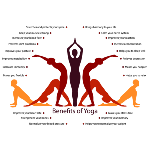Curiosities and Challenges about Yoga
Do you like Yoga?
Would you like to see more curiosities like these..
Despite the common thought that the practice of yoga boils down to complex postures, it is important to highlight that....
The practice of yoga has a philosophy that is influenced by various eastern religions, such as Hinduism and Buddhism...
The practice of yoga is recognized for its spiritual benefits, but it also offers many benefits for our physical....
So.. How about a Challenge on the Best Quiz Platform in the World?
Every scene is an opportunity to shine
Get to know a little about everything and bet on your knowledge in incredible challenges and duels..
Join the betspot.zone community, accumulate bts (bets) and even compete for prizes..
Discover some interesting facts about Yoga..
Quiz - Curiosities - Challenge - - Frequently asked questions about Yoga
World Meditation

World Meditation Day is celebrated on May 21 each year and highlights the ancient practice of meditation, which has gained popularity globally due to its mental health benefits. On this day, monks and experts often offer guidance and tips for those who want to start meditation, highlighting its accessibility and the many benefits it can bring to people of all ages. Meditation is an ancient art, present in various cultures around the world, and has been associated with the concept of mindfulness, which involves focusing attention on the present moment. This day serves as an opportunity to promote the practice of meditation and raise awareness of its benefits around the world, with events and guided practices being held in diverse communities.
celebrate in May 21
publicity
Sanskrit in Yoga: Many yoga terms and postures

Sanskrit in Yoga: Many yoga terms and postures are named in Sanskrit, an ancient Indian language. For example, "asana" means posture, "prana" means life energy, and "Namaste" is a common greeting used at the end of a yoga class.
The Importance of Breathing: Breathing plays a key role in y

The Importance of Breathing: Breathing plays a key role in yoga. Through conscious breathing techniques known as pranayama, practitioners can control and direct the life energy (prana) in their bodies.
The Eight Limbs of Yoga: Patanjali's Yoga Sutras

The Eight Limbs of Yoga: Patanjali's Yoga Sutras is a classic yoga text describing the eight limbs of yoga, known as the Ashtanga. These limbs include moral ethics (Yamas and Niyamas), physical postures (Asanas), breath control (Pranayama), withdrawal of the senses (Pratyahara), concentration (Dharana), meditation (Dhyana), and enlightenment (Samadhi).
publicity
The practice of yoga helps us to connect with ourselves

The practice of yoga helps us to connect with ourselves. It is a means of uniting the body, mind and spirit, thus achieving a greater awareness of ourselves. Through the breathing exercise and the realization of the postures, we reach a state of tranquility and completeness. Meditating also gives us the opportunity to move away from the concepts imposed by society and get closer to our true essence. Thus, the practice of yoga connects us with our interior and helps us to feel more alive.
In order to clarify how yoga began

In order to clarify how yoga began, some believe that the origins of yoga are influenced by the Rig Veda, its oldest religious text. According to some ancient accounts from India, yoga was mentioned in the Rig Veda around 1700 BC, although with the death of the Aryan Invasion Theory this has become difficult to date. Thus, it is possible that it could be at least 7000 years old, or even older, effectively making it the oldest known text. The Rig Veda, originally transmitted orally, was later written down around 3100 BC by the Veda Sage Vyasa. Some historians and Indologists have argued that the Rig Veda can date yoga as far back as 25,920 years. Therefore, while the 7th century BC is still considered the beginning of yoga, it is possible that the origins of this practice go back to the Rig Veda, which certainly makes its history even older.
Many people are unaware

Many people are unaware, but yoga is a moderate-intensity way to exercise and can help with weight loss. This is because it helps to control stress and anxiety, which are triggers for emotional consumption. By practicing postures and exercises, the student can even eliminate 298 calories. However, like any weight loss program, yoga will provide more satisfactory results if combined with a healthy diet.
publicity
Inverted postures have an antigravity action

Inverted postures have an antigravity action, which helps eliminate waste from the body, promotes decongestion in the legs and prevents aging of the skin on the face. This practice contributes to the oxygenation of the brain, increasing the capacity for concentration, reasoning and memory. In this way, it improves blood circulation in the organs responsible for the senses, balances the endocrine glands, with emphasis on the pineal and pituitary.
The practice of yoga

The practice of yoga is recognized for its spiritual benefits, but it also offers many benefits for our physical well-being. Reducing stress, relieving anxiety, reducing the symptoms of depression and alleviating bodily aches and pains are some of the advantages that yoga has to offer. Therefore, there is no doubt that the practice of yoga benefits us both spiritually and physically, helping us to reach a state of harmony and balance.
The practice of yoga has a philosophy that

The practice of yoga has a philosophy that is influenced by various eastern religions, such as Hinduism and Buddhism. It is based on the union between body, mind and spirit. That way, in addition to the physical benefits that the practice brings you, it is possible to visualize more of what it can offer in the emotional and spiritual field. Understanding this, it becomes possible to incorporate yoga as a complete lifestyle.
publicity
Despite the common thought that the practice of yoga boils d

Despite the common thought that the practice of yoga boils down to complex postures, it is important to highlight that several styles exist. From Hatha Yoga, which was the basis for the others, through Iyengar, Kundalini, Vinyasa Flow and Ashtanga Vinyasa Yoga. Each one of them with their goals and ways of working on postures, meditation and breathing. It's interesting to consider which style will bring the best results for you and incorporate it into your routine.
Back
